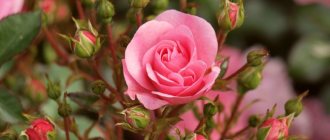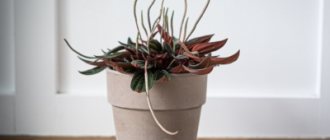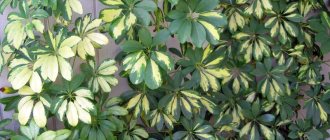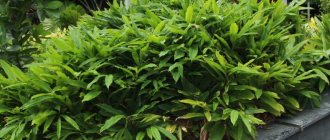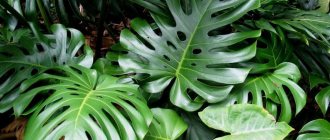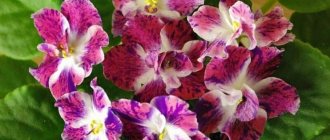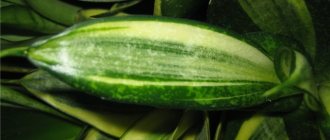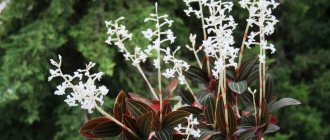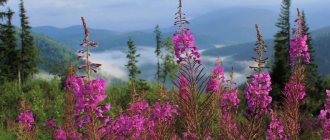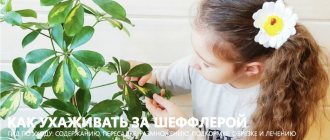Schefflera is extremely capricious for home cultivation. Direct sunlight, waterlogging of the soil, and low air humidity are harmful to it. If not properly cared for, the plant loses its foliage. Its root system can rot, which leads to the death of the plant. Schefflera is often affected by scale insects, spider mites, and mealybugs. So, you have a cheflera, its leaves darken, spots appear on the leaves, they turn yellow, other problems and diseases of the cheflera are noticeable. What to do? How to treat? Recommendations from experts with photos.
Description
Schefflera is a perennial plant of the Araliaceae family, growing in the tropical forests of Southeast Asia, Indonesia, and the Malay Archipelago. The numerous genus is represented by shrubs, vines and trees. Polish physician and botanist Johann Peter Ernst von Scheffler described several species for Reigers' book Tentamen Florae Gedanensis, published in 1776. For his great contribution to science, his name was given to this plant.
Schefflera in nature grows to varying heights from 4 to 20 meters; in indoor conditions, within two to three years it can reach 2 - 2.5 meters. Two species used in indoor floriculture are Schefflera actinophylla (umbrella tree) and Schefflera arboricola (dwarf umbrella tree). The palmate, leathery leaves of the flower grow from one origin, forming a fan very similar to the spokes of an umbrella. External similarity gave the plant the second name “umbrella tree”. Interestingly, in nature, a flower can settle on plant trunks, then a thick root reaches the soil and takes root itself.
Sheffler's photo
There are several popular types of shefflera: palmate, radiate, eight-leaved, tree-like.
Based on them, breeders have created varieties with original colors:
- Charlotte - has green leaves;
- Gerda, Gold Capells, Janine - leaves of yellow-green color with varying saturation;
- Melani - light yellow, almost white leaf color.
Plant species
Also check out these articles
- Cattle breeding
- Autumn varieties of apple trees
- Why do Zamioculcas leaves turn yellow?
- The best varieties of radishes for a greenhouse
More than 200 species of sheflera are known in nature. But no more than 10 are classified as decorative. This gives a certain choice because each of the indoor types has external unique features.
- Radiate or star-leaved schefflera has small leaves, up to 15 cm long and 5 cm wide. Each leaf consists of 8-15 leaf blades. It grows up to 3 meters in height, the leaves are green, the crown is massive.
- Arborescent schefflera produces compound leaves, each of which has 7-9 “fingers” on long petioles. The leaves are leathery, fleshy, with a shiny surface. Plant height is 1.2 meters. The color is green or motley.
- Schefflera palmate has 7-10 “fingers” on an elliptical leaf. The color of the tree is green with bright veins on the leaves. Grows as a compact bush.
- Eight-leaf shefflera is a rare but popular species. Gives 8-11 “fingers” per sheet. The leaves are large, up to 10 cm wide and up to 30 cm long. The leaf color is green with light veins.
In addition, domestic, decorative species include such species as: “Janine”, “Nora”, “Charlotte”, “Luseana” and “Gerda”.
Temperature, watering
All varieties of Schefflera are very light-loving, but cannot tolerate direct sunlight. The plant requires high air humidity and needs regular spraying. In the period until autumn, abundant watering is necessary, soaking the clod of earth, then the excess is poured out of the pan. In winter, shefflera is watered moderately. The best growing temperature in summer is considered to be 18-22 °C, in winter - 14-16 °C, a decrease to 12 °C is detrimental to the flower plant. When maintaining a plant, it is necessary to monitor drafts and isolate them in time.
Control and prevention measures
To save the shefflera from falling leaf plates, it is necessary to observe both the temperature regime and the level of humidity in the air and soil in the room. Irrigation activities are recommended to be carried out regularly and in moderate doses. The flower should be in conditions that are comfortable for it and not experience a shortage of useful components.
Schefflera is a beautiful and relatively unpretentious plant. It can reveal its decorative qualities only with a suitable microclimate and timely application of fertilizer compounds.
Location
All flower varieties can tolerate insufficient lighting when grown indoors, but it will not be possible to grow a spectacular, densely foliated plant. Its internodes will become very elongated, the brightness of the leaves will fade, and the decorative effect will decrease. The best location in the apartment will be the window sills facing south with shading during hot midday hours.
Sheffler's photo
Shefflera should not be placed in brightly sunny places, although the lighting should be maximum.
Growing
To grow shefflera, the soil mixture is made up of turf, leaf, humus soil and sand in a ratio of 2:1:1:1. A layer of drainage must be placed at the bottom of the pot. If it is impossible for plants to grow freely, they form a less fertile mixture for it, which helps limit development. As an additional feeding, various liquid fertilizers for woody and deciduous ornamental plants are used, reducing the proportion specified by the manufacturer. The diluted solution is applied once every two weeks to the tree trunk. When caring for them, they try not to use special feeding sticks, as they provide more concentrated nutrition.
How to transplant Schefflera?
We recommend reading our other articles
- Aphids on cucumbers
- The best varieties of Nectarine
- Schefflera - care and reproduction
- Peat as a substrate for mushrooms
Once a year, in the spring, a young sheflera is transplanted into a new pot or at least into new soil. But an adult tree needs to be replanted every 3 years. If the plant is already very large and it is difficult to replant it, you can simply replace the top layer of soil.
Important!
Caring for cheflera at home involves regular replanting, which should not be neglected even if timely feeding is carried out!
If the pot is changed, it is usually to a larger one. The pan should be deep so that it is convenient to water the plant and then drain all excess water. The soil is taken new, slightly acidic, fertile. You can buy it (the one for palm trees is suitable) or make it yourself from 40% turf, 30% leaf soil, 20% humus, 10% sand.
Before transplanting, drainage (broken brick, charcoal, crushed stone, gravel) is placed on the bottom of the new pot, and then a small layer of earth. After this, the sheflera is taken out of the pot, the old soil is removed from the roots, but not too much, so as not to harm the plant, and placed in a new pot. The roots are spread out on all sides and then covered with layers of earth. All that remains is to water the plant, wait until the soil settles and add the required amount of soil.
Interesting!
To give the sprouts something to rely on, 2-3 plants are usually planted in one pot. As they grow, they are intertwined with stems, if they do not do this themselves. This creates a strong, central stem on which the lush crown rests. But when there is only one plant, it is better to install a support next to it so that the flower does not fall under the weight of the leaves.
Reproduction
The most suitable time to start propagating a flowering plant is spring.
Sheffler's photo
Propagation by cuttings
A reliable way to propagate new plant varieties is propagation by non-lignified stem cuttings. A young, healthy cutting no more than 10 cm high, cut at an acute angle, is placed in a glass with a solution of a growth stimulator (for example, Zircon, 1-2 drops per 1 liter of water) for 1-2 hours.
To root cuttings, choose a small-sized container in which root growth will take place under the most favorable conditions. In a large pot it is difficult to maintain optimal water conditions for the plant. To improve it, a drainage layer of expanded clay or perlite 3-4 cm high is poured onto the bottom of the pot. The soil mixture is made up of turf soil and sand in a 2:1 ratio or turf soil and humus in the same proportion.
The cuttings are placed in a selected container, covered with a plastic bag and placed in a well-lit place. Rooting cuttings are sprayed daily with a spray bottle. The plants gradually begin to ventilate. The first time for 10 minutes, then gradually increase the time. After 3-4 new leaves appear, the plantings are left uncovered for a day, covered at night.
Leaf propagation
You can try to propagate Schefflera by leaf. To do this, select a medium-sized leaf, trying to separate it from the heel (the part attached to the cutting). Then they are placed in a solution of a growth stimulator in settled water. The same means as for cuttings can serve as a stimulant. To grow from leaves, it is recommended to take a larger amount of planting material, since not all of them are able to take root. The leaves are placed in a nutrient solution, a cap is arranged from a suitable material that transmits light, and placed in a warm place with good lighting, avoiding sunlight. After roots form on the leaves, they are planted in small containers, creating greenhouse conditions for rooting using a cap made of transparent material. There is no need to ventilate rooting leaves at first; it is much more important to create suitable conditions for them to grow.
Reproduction by layering
The Schefflera plant can be forced to produce layering. To do this, an incision is made on the side stem, which is covered with layers of moss, cotton wool and film. Moss and cotton wool must be constantly kept moist so that an air shoot can form in this place within 1.5 months. It is carefully separated with the stem from the mother plant and planted in prepared soil.
Seed propagation method
The method of propagation by seeds is quite complicated due to their poor germination. In Russian conditions, according to experts, Schefflera does not bloom, so it cannot produce seeds. Seeds sold may not always meet germination requirements.
Planting work begins in February. The containers are selected wide and deep. A drainage layer of expanded clay is poured onto the bottom. The soil should consist of turf and humus soil. Before sowing, the seeds are soaked in a warm solution of any growth stimulant for 24 hours. They are placed in a sowing container to a depth of 5-6 cm, with a distance between them equal to 2 seed diameters. Cover with film and place in a bright place. Periodically, seeds and seedlings are ventilated by lifting the corner of the film. The room temperature is maintained at 22-25 °C. Transplantation of seedlings into separate pots is carried out when 3 true leaves grow. After this, they try to keep the plants at a temperature of +19 ° C for at least 3 months.
Sheffler's photo
Caring for sheflera at home
Growing conditions
Schefflera is a light-loving plant, so it is placed on a southern, western or eastern windowsill, but during periods of too much sun activity, the plant is covered from direct rays with a light curtain. If you have already received an adult large sheflera, install it near the south window in close proximity to the curtains. In an apartment where there is little light, you should not grow variegated varieties, since they are more light-loving than shefleras with green leaves: due to lack of lighting, variegated leaves become monochromatic.
In summer, sheflera takes well to outdoor holidays in light partial shade, protected from wind and drafts.
The air humidity in the room where the cheflera is located should be above average, and although the plant easily adapts to room conditions, daily spraying with settled water will have a beneficial effect on it. When dust accumulates on sheflera leaves, it is advisable to give it a shower or wipe the leaves with a damp sponge.
In winter, when heating devices are working in the apartment, the sheflera is placed on a tray with wet expanded clay or pebbles, but in such a way that the roots of the plant do not touch the water. As for the temperature, in the summer the cheflera feels normal at the usual temperature for this time, but in the winter she is more comfortable in conditions of 16-18 ºC, the lower limit of winter temperature for the plant is 12 ºC.
Water the sheflera with settled water, preventing the earthen clod from drying out. However, you should refrain from too frequent and abundant watering, which can lead to acidification of the soil and rotting of the roots. The water temperature for watering the cheflera should be the same as the temperature in the room, or a couple of degrees warmer.
Transfer
It is advisable to replant young plants annually in the spring, and adult plants once every few years, as the pot fills with roots. Take a container 5-6 centimeters in diameter larger than the previous pot. Before replanting the shefflera, place a thick layer of drainage in the pot, which will prevent water from stagnating in the roots.
The soil for sheflera requires light, permeable, but at the same time fertile. A soil mixture of three parts compost soil, one part fibrous peat and one and a half parts coarse sand is best suited to the tastes of sheflera, although universal store-bought soil or soil for palm trees will also work. Carefully transfer the shefflera along with the earthen ball into a new pot with a drainage layer, add the required amount of soil mixture, tamping it lightly. After transplantation, the plant is watered.
Fertilizer
Caring for sheflera at home requires mandatory fertilization of the soil in which it grows. Feed the shefflera two to three times a month from March to August with complex mineral fertilizers for ornamental foliage plants in accordance with the manufacturer's instructions, alternating them with a powder of crushed eggshells in the amount of one tablespoon. In winter, the cheflera does not need fertilizing.
Schefflera in winter
When the dormant period begins, the sheflera is placed in a bright room with a temperature no higher than 16-18 ºC, where it will remain until spring. Sheflera in winter does not need as frequent and abundant moisture as in summer, but the principle of watering remains the same: as the top layer of soil in the pot dries. We remind you: in winter the cheflera does not need fertilizers.
Diseases and pests
Even with excellent care, shefflera can get sick or be attacked by pests.
Sign. Cause. Elimination methods.
Stretching the plant, the leaves are far apart. Elevated content temperature. Lack of light. Place in a cooler place. Adjust lighting.
Falling leaves. Low temperature content. Low indoor humidity. Excessive watering. Create a constant room temperature at +16-22 °C. Spray the leaves of the plant.
Water only when necessary, keeping the soil well moistened and draining excess water from the pan.
Paleness and yellowing of leaves. Lack of nutrients. From April to September, with an interval of 10 days, apply mineral complex fertilizers for decorative deciduous plants.
Fading of leaves. Lack of light. Move the flower to a more illuminated place, taking into account that variegated species require more diffused light than green ones.
Formation of dark spots on leaves. Abundant watering when kept at low temperatures. Adjust the amount and frequency of watering.
Watering is carried out with warm, settled water.
Formation of brown edging on leaves. Draft and insufficient watering. Elimination of drafts. Equalize the content temperature. Adjust watering.
Dry tips of leaves. Insufficient ambient humidity. Periodic spraying of leaves.
Root rotting. Abundant watering. Washing the roots in a solution of Fitosporin or Trichodermin, pruning damage and treating with crushed coal. Subsequent replanting into a new soil mixture with a good drainage layer at the bottom of the pot.
Blackening of stems and tops. Rotting of roots located in excessively wet soil. Infection with fungus or stem rot. Trim off the top above the rotting area. Treatment with antifungal drugs.
If there is insufficient control, Schefflera can be damaged by flower pests.
Symptoms. Pest. Control measures.
Detection of sticky dew, yellowing and falling of leaves. Shield. Isolation of the plant from others. Treatment with soap solution and insecticides.
- Aktara (4 g per 5 liters of water);
- Karbofos (6 g per 1 liter of water).
Formation of cobwebs on leaves. Yellowing and wilting of leaves. Spider mite. Increasing air humidity by spraying. Treatment with insecticides.
White coating on the leaves. Delay in plant development. Mealybug. Collection by hand. Treatment with insecticides. Increase in ambient air humidity.
Brown spots on the underside of the leaf, whitish on the top. Yellowing, drying and falling of leaves. Thrips. Treatment with soap solution. In the case of large colonies - treatment with insecticides.
Sheffler's photo
Planting and caring for cheflera
- Flowering: the plant is grown as an ornamental foliage plant.
- Lighting: bright light in the first half of the day, bright diffused light or light partial shade in the second (eastern and western window sills). You can keep the sheflera near the south window, but behind a light curtain. Variegated varieties are more light-loving than forms with monochrome leaves.
- Temperature: during the growing season - normal for residential premises, in winter - 16-18 ˚C, lower temperature threshold - 12 ˚C.
- Watering: regular, moderate, rare during cool winters.
- Air humidity: above average. It is recommended to spray the leaves with warm soft water, especially in hot weather and during wintering in a warm room.
- Fertilizing: from March to August 2-3 times a month with complex fertilizer for decorative deciduous crops. The rest of the time, no fertilizing is applied.
- Dormant period: from September to February.
- Transplantation: young plants are replanted annually, adults - as needed. Transplantation is carried out in the spring, at the beginning of active growth.
- Reproduction: seeds, air layering and cuttings.
- Pests: aphids, thrips, scale insects, spider mites.
- Diseases: from chronic waterlogging of the soil - root rot, due to poor care - loss of decorative qualities.
Read more about growing sheflera below.
Reviews
According to numerous reviews from gardeners, Schefflera is a fast-growing plant that is grateful for care. Contrary to the claims of breeders that it does not bloom in indoor conditions, a miracle happens in good hands. believe in you on her Internet page on April 20, 2015 she presented photographs of a flower with a released cone.
Irina also posted photographs of her variegated shefflera on March 14, 2016, accompanied by interesting material. The owner took care of him for more than 10 years and took him with her when moving. Schefflera bloomed after forced pruning due to pest damage. The hostess was pleased with the flower's gratitude.
Without exception, all amateur flower growers note the unpretentiousness of keeping shefflera, its rapid growth and the atmosphere that it creates in the home. Beautiful, original, feathery leaves delight the eye all year round. If a gardener is lucky enough to see a flower bloom, he rejoices doubly.
Sheffler's photo
Types and varieties of shefflera
There are more than two hundred varieties of Schefflera in the world, but not all of them are grown as indoor plants. The most common are low-growing varieties with bright spreading foliage.
| View | Peculiarities |
| Amate | Very large dark green leaves without spots, with a waxy sheen. Shade-loving. Up to 2.5 m high. |
| Bianca | The leaves are short, dark green, with yellow jagged edges. |
| Eight leaf | The leaves are green with yellow spots, each consisting of eight oval plates and dotted with small light needles. Reaches 2 m. |
| Gerda | Variegated leaves of dark and light green. Height 0.5-2.5 m. |
| Gold Capella | The trunk is straight and long. The leaves are large, bright green with golden spots. It reaches a height of 120 cm. |
| Treelike (Arboricola) | Composite light green leaves with round tips are densely located on a straight trunk and decorated with rare yellow streaks. |
| Custer | Dark green, smooth foliage without spots. Reaches 120 cm. |
| Louisiana | Beautiful glossy leaves in variegated green shades. |
| Radifolia (Star-leaved) | It is most often found indoors. Large leaves of different shades of green, with cloves at the ends. Red flowers. Up to 2.5 m. |
| Melanie | The leaves are large and an unusual greenish-yellow color, often with dark green edges or spots. Unpretentious. Height up to 1.5 m. |
| Moondrop (Moondrop) | Multi-barreled. The leaves are small, green with yellow spots. Up to 40 cm. |
| Nora | The leaves are dense, narrow, with yellow speckles. |
| Palmate | Dark green leaves with pronounced veins and sharp ends. Large inflorescences. |
| Variegated | The leaves are partly dark green, partly yellow. Unpretentious. D 1.5 m. |
| Spotted | Large leaves with yellow streaks and jagged edges. Unpretentious. |
| Charlotte | The leaves are light yellow above and dark green below, shaped like hearts. Unpretentious. Short. |
